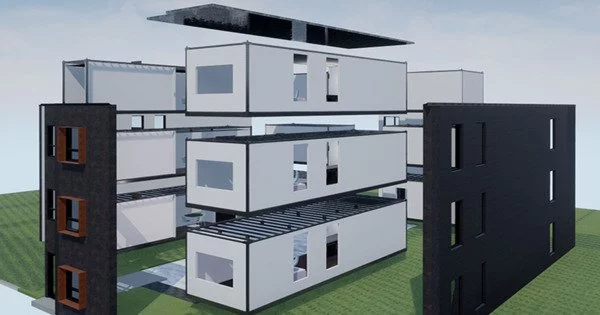A modular building is a prefabricated structure made up of repeated sections known as modules. Modularity entails constructing sections away from the construction site and then transporting them to the intended location. These modules are constructed off-site in a factory-controlled environment before being transported to the construction site and assembled into the final structure. On-site assembly of the prefabricated sections is completed.
A crane is sometimes used to place prefabricated sections. The modules can be stacked, side-by-side, or end-to-end, allowing for a wide range of configurations and styles. Inter-module connections, also known as interconnections, are used to connect the modules after they have been placed. The interconnections connect the individual modules to form the overall structure of the building.
Modular buildings can be used for a variety of applications, including residential, commercial, and institutional uses. They can be single-story or multi-story structures that are built to meet various building codes and requirements. Houses, apartments, schools, offices, hotels, hospitals, and retail spaces are all examples of modular structures.
There are several advantages to modular construction:
- Speed and efficiency: Since the modules are constructed simultaneously off-site while site preparation is underway, the overall construction time is significantly reduced compared to traditional construction methods. This can lead to faster project completion and earlier occupancy.
- Cost-effective: Modular construction can be cost-effective due to factors such as reduced labor requirements, efficient material usage, and economies of scale in the factory-controlled environment. It also allows for better cost control and minimizes the risk of delays or cost overruns.
- Flexibility and adaptability: Modular structures are built to be easily assembled, disassembled, and relocated. As a result, they are suitable for both temporary and permanent structures, and they can be expanded or reconfigured as needed in the future.
- Sustainability: Sustainable practices such as efficient material usage, reduced waste generation, and energy-efficient designs are frequently used in modular construction. Furthermore, the controlled factory environment allows for recycling and waste management practices to be implemented.
Despite these advantages, modular construction also has some considerations:
- Design limitations: When compared to traditional construction, modular buildings are typically built using standard module sizes, which limits design flexibility. Modular construction techniques, on the other hand, are allowing for more design options and customization.
- Site preparation: While the modules are being built off-site, the construction site must be prepared, which includes foundation work and utility connections. To ensure a smooth construction process, proper coordination between off-site and on-site activities is required.
- Permits and regulations: Modular buildings, like traditional structures, must adhere to local building codes and regulations. It is critical to collaborate closely with local authorities and obtain all necessary permits and approvals.
Modular construction is gaining popularity due to its numerous benefits, and it is constantly evolving as technology and construction practices advance. It provides an efficient, high-quality, and long-term alternative to traditional construction methods.
















